Erosion and Karst in Subsurface Middle Paleozoic Rocks in the Arkoma Basin, Oklahoma, USA
Abstract
1. Introduction
2. Purpose of Study
3. Previous Studies
4. Geologic Setting
4.1. Structure and Tectonics
4.2. Stratigraphy and Depositional Environment
5. Methodology
6. Interpretation
6.1. Seismic Character of the Hunton
6.2. Imaging Collapse Features Within the Viola Group
6.3. Using Amplitude Extractions to Characterize the Hunton Wedges
6.4. Using Waveform Classification to Differentiate Hunton from Viola Rocks
6.5. Modelling Hunton Preservation
6.6. Regional View
7. Discussion
7.1. Geological Mechanism for Karst Collapse Structures
7.2. Potential for Solution Collapse Within the Viola
- Post-Viola/pre-Woodford fracture sets formed (trending east-northeast) in response to regional uplift during the Middle Devonian period.
- Karst solution weathering occurred between the post-Hunton and pre-Woodford periods, especially along vertical fractures trending northeast, where water seepage was intensified. This process created large caverns in some carbonate units, notably the Welling Member of the Viola Group.
- As uplift continued and the regional water table lowered, extensive Viola dissolution and collapse occurred.
- The resulting collapse structures caused Hunton rocks to fall below the paleo-regional base level, thereby protecting them from later widespread erosion.
- Episodes of collapse likely persisted until most of the solution caverns had caved in and filled from above, causing the overlying strata to sag.
- Due to the resistive nature of most of the Hunton Group, the collapsed Hunton lenses formed depositional highs as the Woodford Sea advanced and eventually submerged the region, causing the thinning of the resulting Woodford Shale over them.
8. Conclusions
Author Contributions
Funding
Data Availability Statement
Acknowledgments
Conflicts of Interest
References
- Amsden, T.W. Hunton Group (Ordovician, Silurian, Early Devonian) in the Arkoma Basin of Oklahoma. Okla. Geol. Surv. Bull. 1980, 129, 136. [Google Scholar]
- Torres-Parada, E.J. Woodford Shale Enclosed Mini-Basin Fill on the Hunton Paleo Shelf. A Depositional Model for Unconventional Resource Shales. Ph.D. Thesis, University of Oklahoma, Norman, OK, USA, 2020. Available online: https://hdl.handle.net/11244/323811 (accessed on 1 May 2025).
- Houseknecht, D.W.; Rouse, W.A.; Paxton, S.T.; Mars, J.C.; Fulk, B. Upper Devonian-Mississippian stratigraphic framework of the Arkoma Basin and distribution of potential source-rock facies in the Woodford-Chattanooga and Fayetteville-Caney shale-gas systems. AAPG Bull. 2014, 98, 1739–1759. [Google Scholar] [CrossRef]
- Evervus Intelligence Research Inc. U.S. Production and Well Data: Database Available from Enervus Intelligence Research, 2901 Via Fortuna #200, Austin, TX, USA. Available online: https://www.enverus.com/solutions/energy-analytics/land/ (accessed on 1 April 2022).
- Amsden, T.W. Depositional and post-depositional history of Middle Paleozoic (Late Ordovician through Early Devonian) strata in the ancestral Anadarko Basin. Okla. Geol. Surv. Circ. 1989, 90, 143–146. [Google Scholar]
- Shannon, J.P., Jr. Hunton Group (Silurian-Devonian) and related Strata in Oklahoma. AAPG Bull. 1962, 46, 1–29. [Google Scholar] [CrossRef]
- Northcutt, R.A. History of Hunton oil and gas exploration and development in Oklahoma, Part III. In Hunton Play in Oklahoma (Including Northeast Texas Panhandle); Special Publication 2000-2; Oklahoma Geological Survey: Oklahoma City, OK, USA, 2000; pp. 9–20. Available online: http://ogs.ou.edu/docs/specialpublications/SP2000-2.pdf (accessed on 1 April 2025).
- Tarr, R.S. Paleogeologic map at base of Woodford, and Hunton isopachous map of Oklahoma. AAPG Bull. 1955, 39, 1851–1858. [Google Scholar] [CrossRef]
- Maxwell, R.W. Post-Hunton Pre-Woodford unconformity in Southern Oklahoma; Petroleum Geology of Southern Oklahoma—A Symposium; American Association of Petroleum Geologists: Tulsa, OK, USA, 1959; Volume 2, pp. 101–126. [Google Scholar]
- England, R.L. Subsurface study of the Hunton Group (Silurian-Devonian) in the Oklahoma portion of the Arkoma Basin. Shale Shak. Dig. IV 1961, 12, 19–35. [Google Scholar]
- Rottman, K. Defining the role of Woodford-Hunton depositional relationships in Hunton stratigraphic traps of western Oklahoma. In Platform Carbonates of the Southern Midcontinent; Johnson, K.S., Ed.; Circular 101; Oklahoma Geological Survey: Norman, OK, USA, 2000; pp. 139–146. [Google Scholar]
- Valderrama, M.H.; Nielsen, K.C.; McMechan, G.A. Three-dimensional seismic interpretation from the Triangle Zone of the Frontal Ouachita Mountains and Arkoma Basin, Pittsburg County, Oklahoma. AAPG Bull. 1996, 80, 1185–1202. [Google Scholar] [CrossRef]
- Rottman, K. Hunton stratigraphy, Part IV. In Hunton Play in Oklahoma (Including Northeast Texas Panhandle); Special Publication 2000-2; Oklahoma Geological Survey: Oklahoma City, OK, USA, 2000; pp. 21–38. Available online: http://ogs.ou.edu/docs/specialpublications/SP2000-2.pdf (accessed on 9 July 2023).
- Houseknecht, D.W.; McGilvery, T.A. Red Oak field. In Structural Traps II. Traps Associated with Tectonic Faulting: AAPG Treatise of Petroleum Geology Atlas of Oil and Gas Fields; Beaumont, E.A.; Foster, N.H., Translators; The American Association of Petroleum Geologists (AAPG): Tulsa, OK, USA, 1990; pp. 201–225. [Google Scholar]
- Rutty, P.; Schlaefer, J.; Vizurrage, A. Exploitation utilizing 3D seismic in the Red Oak gas field of the Arkoma basin, Oklahoma, USA (abstract). AAPG Bull. 1995, 79, 1406–1407. [Google Scholar]
- Rutty, P.M. Exploitation Using 3D Seismic in the Red Oak Field, Arkoma Basin, Oklahoma; Transactions of the 1995 AAPG Mid-Continent Section Meeting; American Association of Petroleum Geologists: Tulsa, OK, USA, 1996; Available online: https://archives.datapages.com/data/tgs/tgs-sp/data/049/049001/62_tgs-sp0490062.htm (accessed on 2 February 2024).
- Cardott, B.J. Bibliography of Arkoma Basin and Cherokee Platform. 2021. Available online: https://ou.edu/content/dam/ogs/documents/information/Bibliographies-basins/Arkoma-Basin-and-Cherokee-Platform.pdf (accessed on 8 January 2024).
- Durham, L.S. Old basin, new interest; 3-D use rises in Arkoma. AAPG Explor. 2011, 32, 12. Available online: https://explorer.aapg.org/Portals/0/docs/Explorer/2011/03mar/03explorer11.pdf (accessed on 2 December 2024).
- Aboaba, O.; Liner, C. Interpretation of Paleozoic paleokarst features in the Arkoma Basin of Oklahoma using 3D seismic and well logs. Interpretation 2020, 8, T421–T440. [Google Scholar] [CrossRef]
- Ibrahim, Ç.; Fuchs, J.; Coffey, B.; Gertson, R.; Hager, C. Correlating Porosity with Acoustic Impedance in Sandstone Gas Reservoirs: Examples from the Atokan Sandstones of the Arkoma Basin, Southeastern Oklahoma. 2014 Search and Discovery Article #41255. Available online: https://www.searchanddiscovery.com/pdfz/documents/2014/41255cemen/ndx_cemen.pdf.html (accessed on 6 January 2024).
- Fuchs, J.C. Using 3-D Seismic Inversion Data as a Tool for Predicting Porosity in the Wilburton Gas Field, Arkoma Basin, Southeastern Oklahoma. Master’s Thesis, University of Alabama, Tuscaloosa, AL, USA, 2012. Available online: https://ir.ua.edu/handle/123456789/1624 (accessed on 9 July 2023).
- Torres, E.J.; Slatt, R.M.; Marfurt, K.J.; Infante, L.E.; Castillo, L.A. Identification of potential lacustrine stratigraphic intervals in the Woodford Shale, Oklahoma, using multi-attribute 3-D seismic displays and a supervised neural network. In Proceedings of the Unconventional Resources Technology Conference, Austin, TX, USA, 24–26 July 2017. [Google Scholar] [CrossRef]
- Milad, B.; Slatt, R. Integrated 3-D Seismic and Core Data for Characterization of Natural Fractures of the Hunton Limestone and the Woodford Shale in Central Oklahoma. In Proceedings of the AAPG Annual Convention and Exhibition, Houston, TX, USA, 4 April 2017; Available online: https://www.searchanddiscovery.com/abstracts/html/2017/90291ace/abstracts/2609796.html (accessed on 9 July 2023).
- Milad, B. The Effect of Karsting on Natural Fracture, Hardness, and Brittleness of the Hunton Limestone and Paleo-Deposition of the Woodford Shale: A Study Using 3-D Seismic, Outcrop, Well Log, and Core Data. Search and Discovery Article #51417. 2017. Available online: https://www.searchanddiscovery.com/pdfz/documents/2017/51417milad/ndx_milad.pdf.html (accessed on 23 January 2024).
- Whitaker, A.E.; Engelder, T. Plate-scale stress fields driving the tectonic evolution of the central Ouachita salient, Oklahoma and Arkansas. GSA Bull. 2006, 118, 710–723. [Google Scholar] [CrossRef]
- Lutz, B.M.; Hudson, M.R.; Smith, T.M.; Dechesne, M.; Spangler, L.R.; McCafferty, A.E.; Amarel, C.M.; Griffis, N.P.; Hirtz, J.A. Influence of inherited structure on flexural extension in foreland basin systems: Evidence from the northern Arkoma basin and southern Ozark dome, USA. Earth Sci. Rev. 2024, 251, 104715. [Google Scholar] [CrossRef]
- Amsden, T.W. Arkoma Basin model: Middle Ordovician through Early Devonian. In Proceedings of the 1981 AAPG Mid-Continent Regional Meeting, 1984, Oklahoma City, OK, USA, 1 August 1981; pp. 116–118. Available online: https://archives.datapages.com/data/ocgs/data/028/028001/116_ocgssp280116.htm (accessed on 6 January 2025).
- Arbenz, J.K. Ouachita thrust belt and Arkoma basin. In The Geology of North America, Volume F-2, the Appalachian-Ouachita Orogen in the United States; Hatcher, R.D., Jr., Viele, G.W., Eds.; Geological Society of America: Boulder, CO, USA, 1989; Volume F-2, pp. 621–634. [Google Scholar]
- Suneson, N.H.; Campbell, J.A.; Tilford, M.J. Geologic setting and introduction. In Geology and Resources of the Frontal Belt of the Western Ouachita Mountains, Oklahoma; Suneson, N.H., Campbell, J.A., Tilford, M.J., Eds.; Special Publication 90-1; Oklahoma Geological Survey: Norman, OK, USA, 1990; p. 1. [Google Scholar]
- Lillie, R.J.; Nelson, K.D.; De Voogd, B.; Brewer, J.A.; Oliver, J.E.; Brown, L.D.; Kaufman, S.; Viele, G.W. Crustal structure of Ouachita Mountains, Arkansas: A model based of integration of COCORP reflection profiles and regional geophysical data. AAPG Bull. 1983, 67, 907–931. [Google Scholar] [CrossRef]
- Thomas, W.A.; Viele, G.W. Tectonic history of the Ouachita Orogen. Geology 1983, 11, 482–483. [Google Scholar] [CrossRef]
- Thomas, W.A. The Appalachian–Ouachita rifted margin of southeastern North America. GSA Bull. 1991, 103, 415–431. [Google Scholar] [CrossRef]
- Houseknecht, D.W. Evolution from passive margin to foreland basin: The Atoka formation of the Arkoma Basin, south-central USA. Spec. Publs. Int. Ass. Sediment. 1986, 8, 327–345. [Google Scholar] [CrossRef]
- Sutherland, P.K. Late Mississippian and Pennsylvanian depositional history in the Arkoma basin area, Oklahoma and Arkansas. GSA Bull. 1988, 100, 1787–1802. [Google Scholar] [CrossRef]
- Al-Shaieb, Z.; Puckette, J.O.; Blubaugh, P. The Hunton Group: Sequence stratigraphy, facies, dolomitization, and karstification, Part V. In Hunton Play in Oklahoma (Including Northeast Texas Panhandle); Special Publication 2000-2; Oklahoma Geological Survey: Oklahoma City, OK, USA, 2000; pp. 39–50. Available online: http://ogs.ou.edu/docs/specialpublications/SP2000-2.pdf (accessed on 9 July 2023).
- Fritz, R.D.; Medlock, P.L. Recognition of unconformities and sequences in Mid-Continent carbonates. In Sequence Stratigraphy of the Mid-Continent; Hyne, N.J., Ed.; Special Publication, No. 4; Tulsa Geological Society: Tulsa, OK, USA, 1995; pp. 49–80. [Google Scholar]
- Hollrah, T.L. Subsurface lithostratigraphy of the Hunton Group, in parts of Payne, Lincoln and Logan Counties, Oklahoma. Shale Shak. Dig. IX 1978, 27, 76–91. [Google Scholar]
- Kuykendall, M.D.; Fritz, R.D. Misener Sandstone: Distribution and relationship to Late/Post-Hunton Unconformities, Northern Shelf, Anadarko Basin. In Hunton Group Core Workshop and Field Trip; Johnson, K.S., Ed.; Special Publication 93-4; Oklahoma Geological Survey: Oklahoma City, OK, USA, 1993; pp. 117–134. Available online: http://ogs.ou.edu/docs/specialpublications/SP93-4.pdf (accessed on 7 July 2022).
- Amsden, T.W. Stratigraphy of the Frisco and Sallisaw formations (Devonian) of Oklahoma. Okla. Geol. Surv. Bull. 1961, 90, 1–121. Available online: http://ogs.ou.edu/docs/bulletins/B90.pdf (accessed on 6 July 2021).
- Matthews, F.D. Paleokarstic features and reservoir characteristics of the Hunton Group in the Anadarko Basin, Oklahoma. Shale Shak. 1994, 44, 102–109. [Google Scholar]
- Sykes, M. Paleokarst characteristics of the surface and subsurface in the Viola Limestone (Ordovician), Arbuckle Mountains, Oklahoma. Shale Shak. 1997, 47, 107–121. [Google Scholar]
- Biggs, D.S.C. Clearing up deconvolution. Biophotonics Int. 2004, Feb., 2–10. [Google Scholar]
- Addison, P.S. The Illustrated Wavelet Transform Handbook; Taylor and Francis: New York, NY, USA, 2002. [Google Scholar]
- Brinkerhoff, A.R. Mapping Middle Paleozoic Erosional and Karstic Patterns with 3-D Seismic Attributes and Well Data in the Arkoma Basin, Oklahoma. Master’s Thesis, Brigham Young University, Provo, UT, USA, 5 June 2007. Available online: https://scholarsarchive.byu.edu/etd/907/ (accessed on 12 July 2008).
- Brown, A.R. Interpretation of 3-Dimensional Seismic Data, 5th ed.; AAPG Memoir 42; American Association of Petroleum Geology: Tulsa, OK, USA, 2004; pp. 174–175; 233, 341. Available online: https://library.seg.org/doi/pdf/10.1190/1.9781560802884.fm (accessed on 6 July 2021).
- Kumbalek, M. Analysis of Paleokarst Sinkholes in the Arkoma Basin Using 3-D Seismic. Master’s Thesis, University of Arkansas, Fayetteville, AR, USA, May 2015. Available online: https://scholarworks.uark.edu/etd/1104 (accessed on 4 July 2021).
- Haber, A.; Wilk, A. Application of new techniques in the seismic data interpretation to enhance their examination effectiveness. Acta Montan. Slovaca 2006, 11, 51–55. [Google Scholar]
- Mairs, T. A subsurface study of the Fernvale and Viola formations in the Oklahoma portion of the Arkoma Basin. Tulsa Geol. Soc. Dig. 1966, 34, 60–81. [Google Scholar]
- Andersen, E.; Boyd, J. Seismic waveform classification: Techniques and benefits. CSEG Rec. 2004, 29, 26–30. Available online: https://csegrecorder.com/articles/view/seismic-waveform-classification-techniques-and-benefits (accessed on 4 June 2024).
- Johnson, J.G.; Klapper, G.; Sandberg, C.A. Devonian eustatic fluctuations in Euramerica. GSA Bull. 1985, 96, 567–587. [Google Scholar] [CrossRef]
- Maxwell, R.A. The Stratigraphy and Areal Distribution of the Hunton Formation, Oklahoma. Ph.D. Thesis, Northwestern University, Evanston, IL, USA, 1 August 1936. [Google Scholar]
- Al Shaieb, Z.; Puckette, J. Sequence stratigraphy of Hunton Group ramp facies, Arbuckle Mountains and Anadarko Basin, Oklahoma. In Platform Carbonates of the Southern Midcontinent, 1996 Symposium; Johnson, K.S., Ed.; Circular 101; Oklahoma Geological Survey: Norman, OK, USA, 2002; pp. 131–137.53. [Google Scholar]
- Loucks, R.G.; Mescher, P.K.; McMechan, G.A. Three-dimensional architecture of a coalesced, collapsed paleocave system in the Lower Ordovician Ellenburger Group, central Texas. AAPG Bull. 2004, 88, 545–564. [Google Scholar] [CrossRef]
- Loucks, R.G. Paleocave carbonate reservoirs: Origins, burial-depth modifications, spatial complexity, and reservoir implications. AAPG Bull. 1999, 83, 1795–1834. [Google Scholar] [CrossRef]
- Loucks, R.G. A Review of coalesced, collapsed-paleocave systems and associated suprastratal deformation. Acta Carsologica/Karsoslovni Zb. 2007, 36, 121–132. [Google Scholar] [CrossRef]
- Lucia, F.J. Lower Paleozoic cavern development, collapse, and dolomitization, Franklin Mountains, El Paso, Texas. In Unconformities and Porosity in Carbonate Strata; Budd, D.A., Saller, A.H., Harris, P.M., Eds.; AAPG Memoir 63; American Association of Petroleum Geologists: Tulsa, OK, USA, 1995; pp. 279–300. [Google Scholar] [CrossRef]
- Bellian, J.A. Laser-Mapping and 3-D Reconstruction of the Lower Ordovician El Paso Group Breccia Collapse Breccias, Franklin Mountains, Texas. Ph.D. Thesis, University of Texas, Austin, TX, USA, August 2009. Available online: https://hdl.handle.net/2152/9669 (accessed on 3 November 2023).
- Aboaba, O.A. Seismic Expressions of Paleokarst. Ph.D. Thesis, University of Arkansas, Fayetteville, AR, USA, December 2020. Available online: https://scholarworks.uark.edu/etd/3915 (accessed on 3 May 2024).
- Hardage, B.A.; Carr, D.L.; Lancaster, D.E.; Simmons, J.L., Jr.; Elphick, R.Y.; Pendleton, V.M.; Johns, R.A. 3-D Seismic evidence of the effects of carbonate karst collapse on overlying clastic stratigraphic and reservoir compartmentalization. Geophysics 1996, 61, 1336–1350. [Google Scholar] [CrossRef]
- Merriam, D.F.; Atkinson, W.R. Simpson Filled Sinkholes in Eastern Kansas; Bulletin 119, Part 2; Kansas Geological Survey: Lawrence, KS, USA, 1956. Available online: www.kgs.ku.edu/Publications/Bulletins/119_2/ (accessed on 2 August 2023).
- Sanders, J.I.; Steel, G. Improved structural resolution from 3D surveys in Australia. Aust. Pet. Explor. Assoc. J. 1982, 22, 17–41. [Google Scholar] [CrossRef]
- Sykes, M.; Puckette, J.; Abdalla, A.; Al-Shaieb, Z. Karst development in the Viola Limestone in southern Oklahoma. In Simpson and Viola Groups in the Southern Midcontinent, 1994 Symposium; Johnson, K.S., Ed.; Circular 99; Oklahoma Geological Survey: Norman, OK, USA, 1997; pp. 66–75. [Google Scholar]
- Payne, E.N. Analysis of an Exposure of the Viola Group in the Arbuckle Mountains, Southern Oklahoma. Master’s Thesis, Texas Christian University, Fort Worth, TX, USA, August 2008. Available online: https://repository.tcu.edu/handle/116099117/4094 (accessed on 4 September 2015).
- White, W.B. Geomorphology and Hydrology of Karst Terrains; Oxford University Press: Oxford, UK, 1988; p. 464. Available online: https://digitalcommons.usf.edu/kip_articles/2160 (accessed on 1 May 2024).


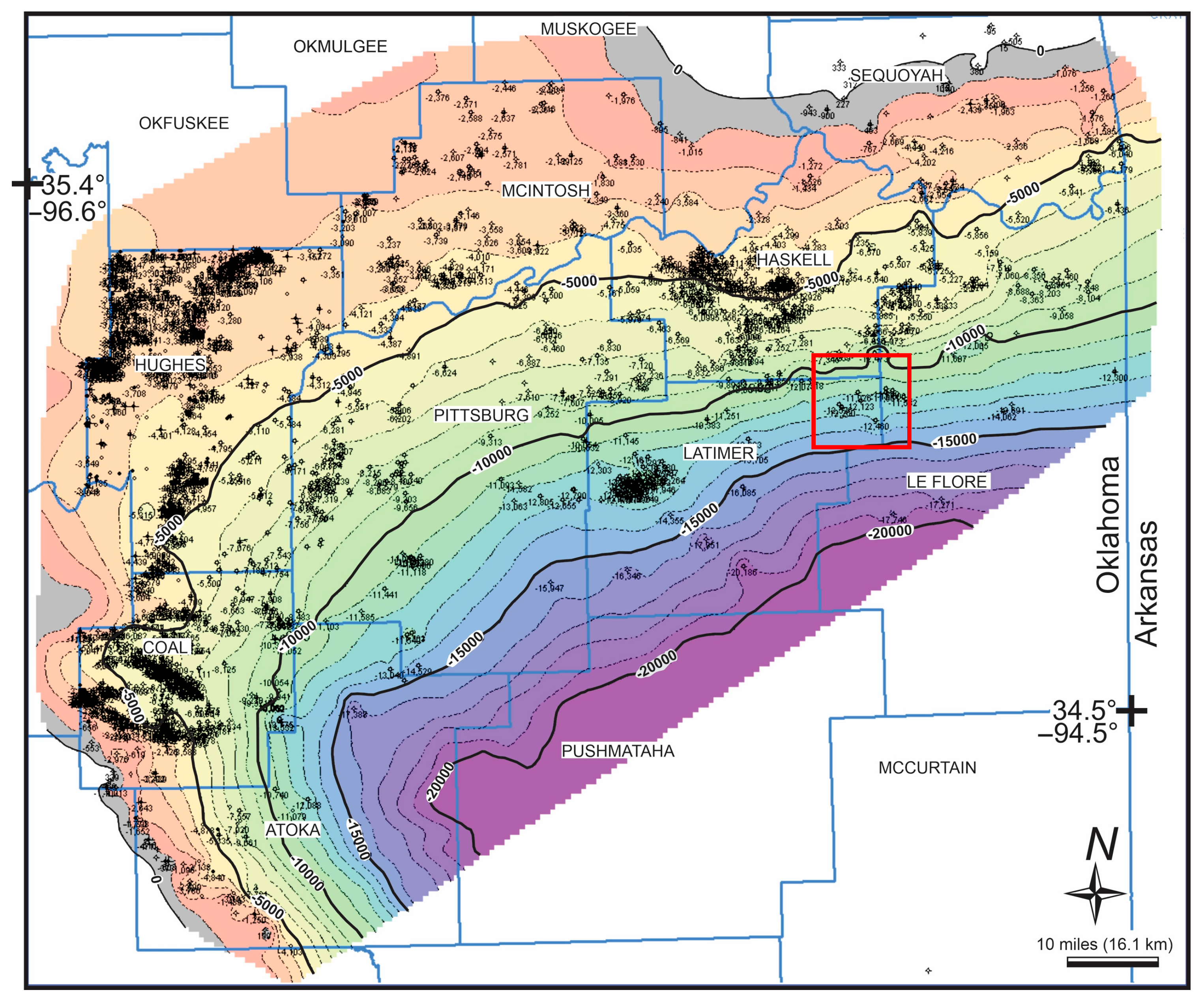
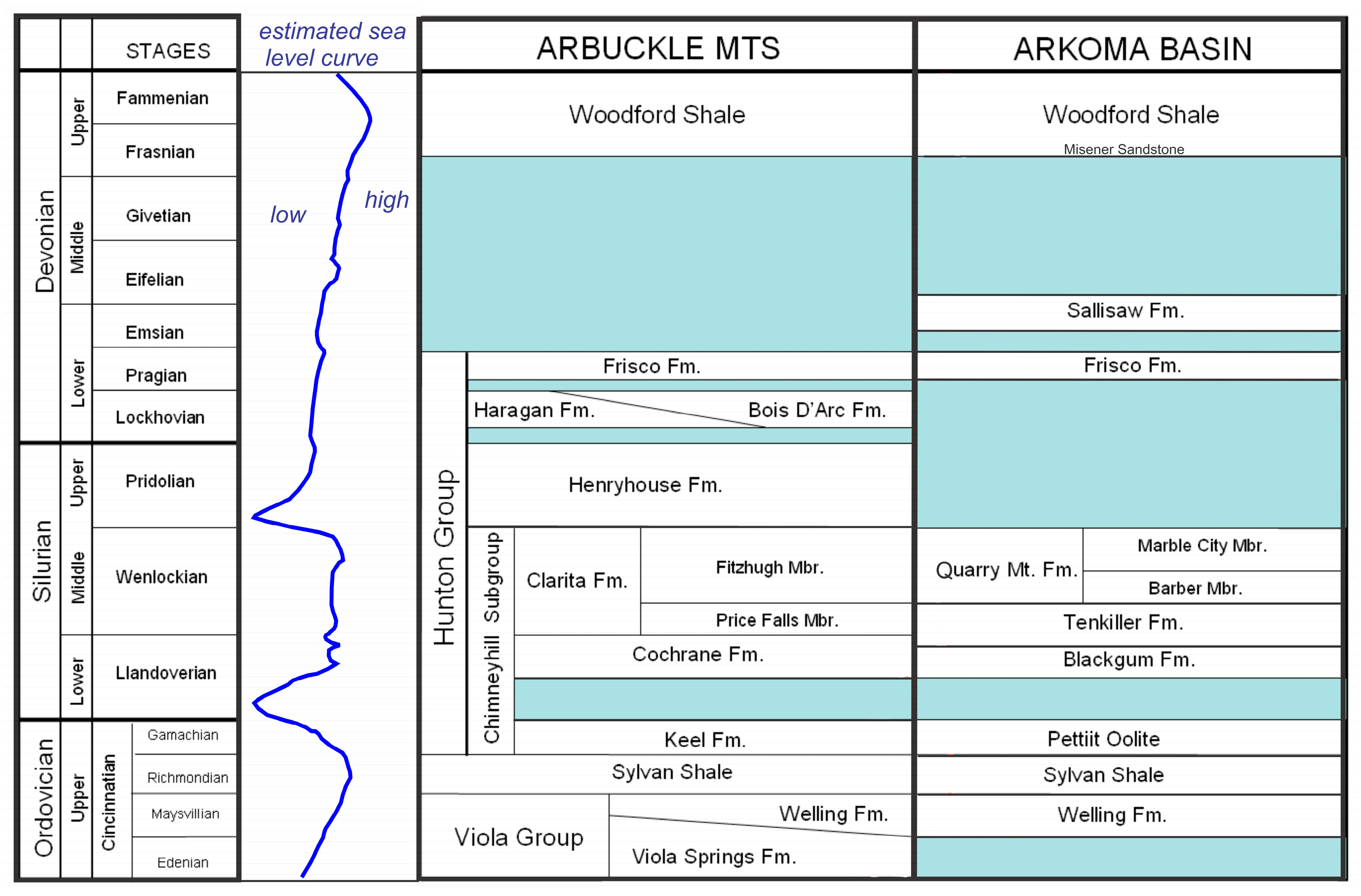
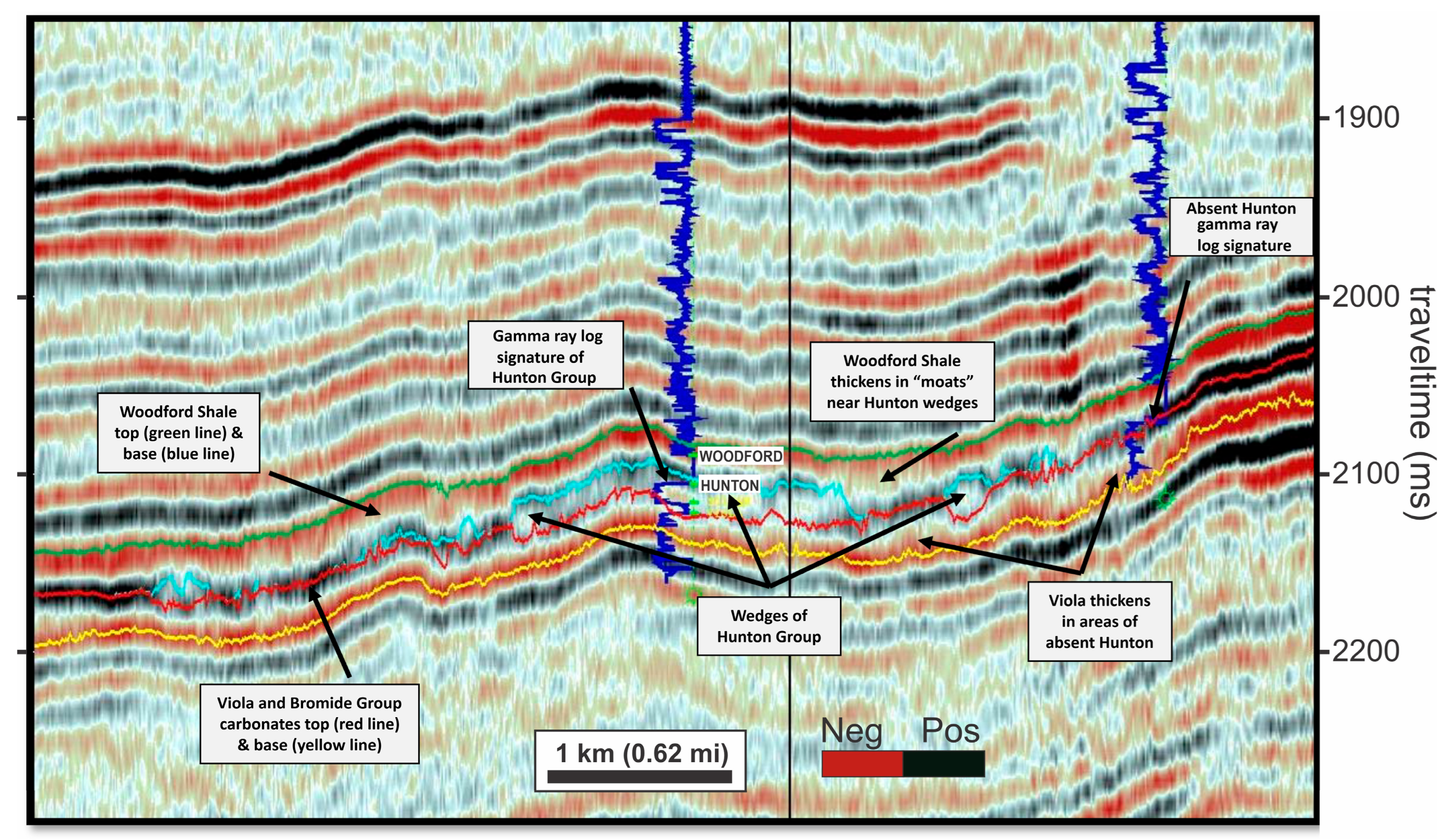

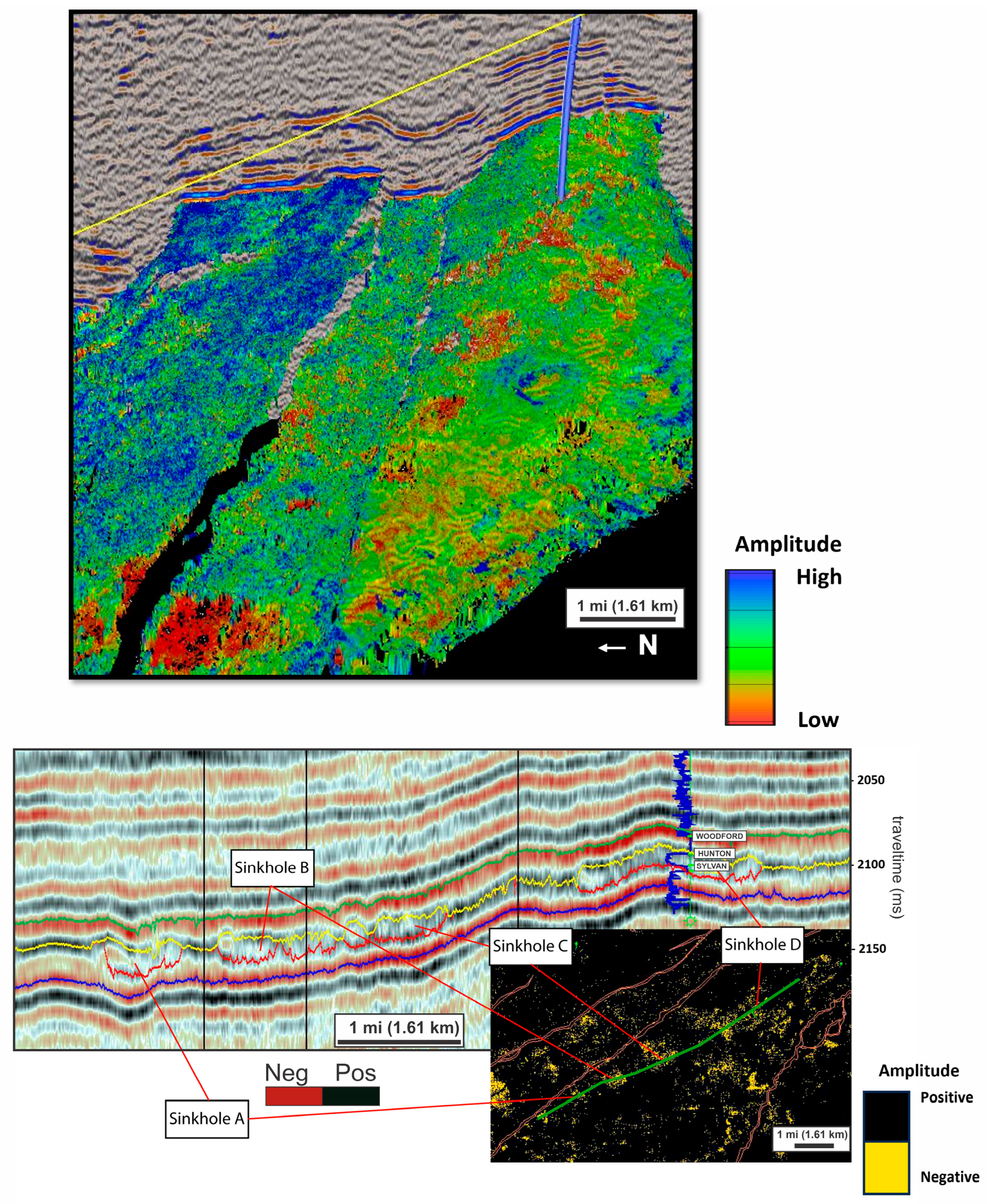
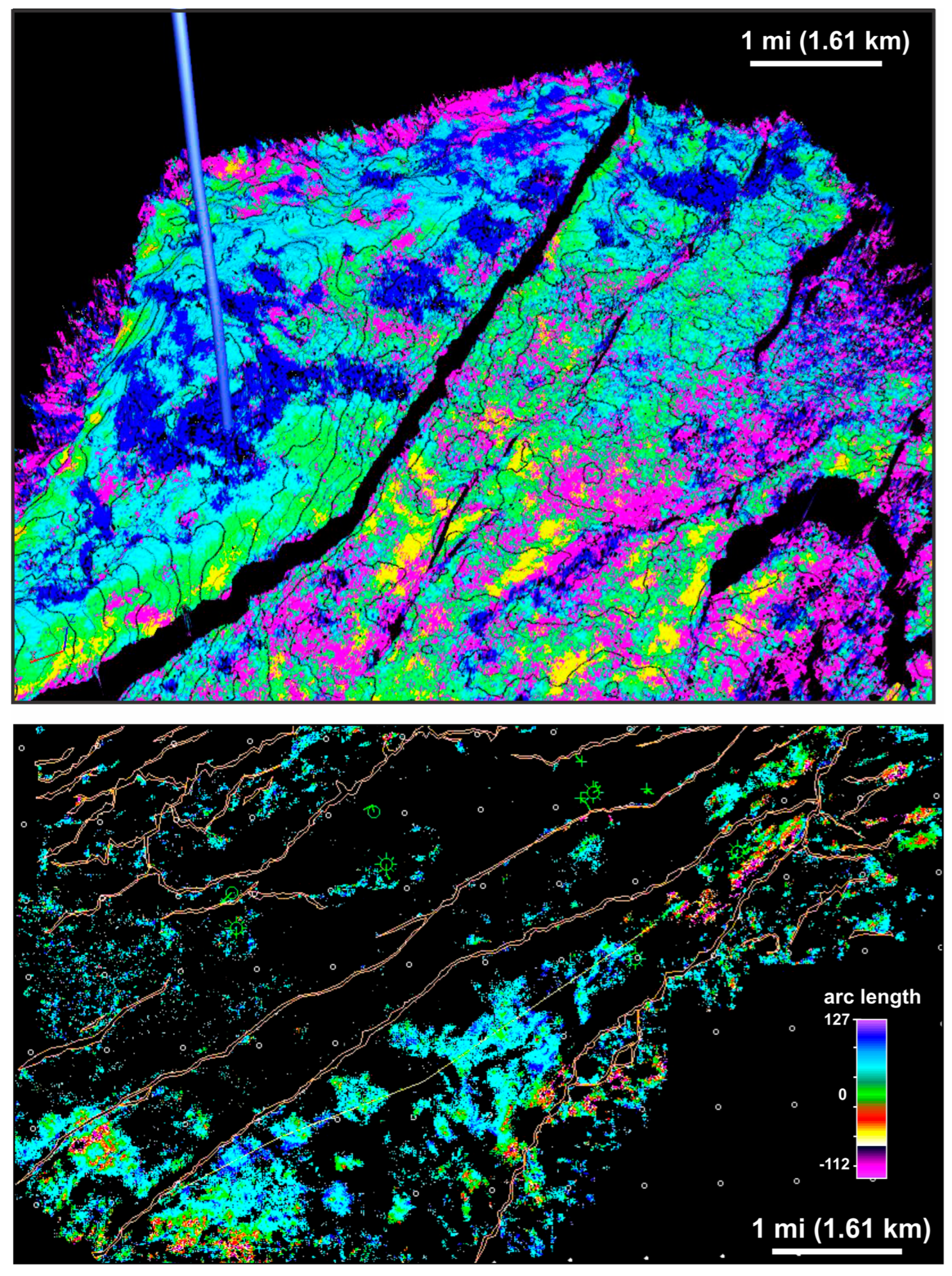

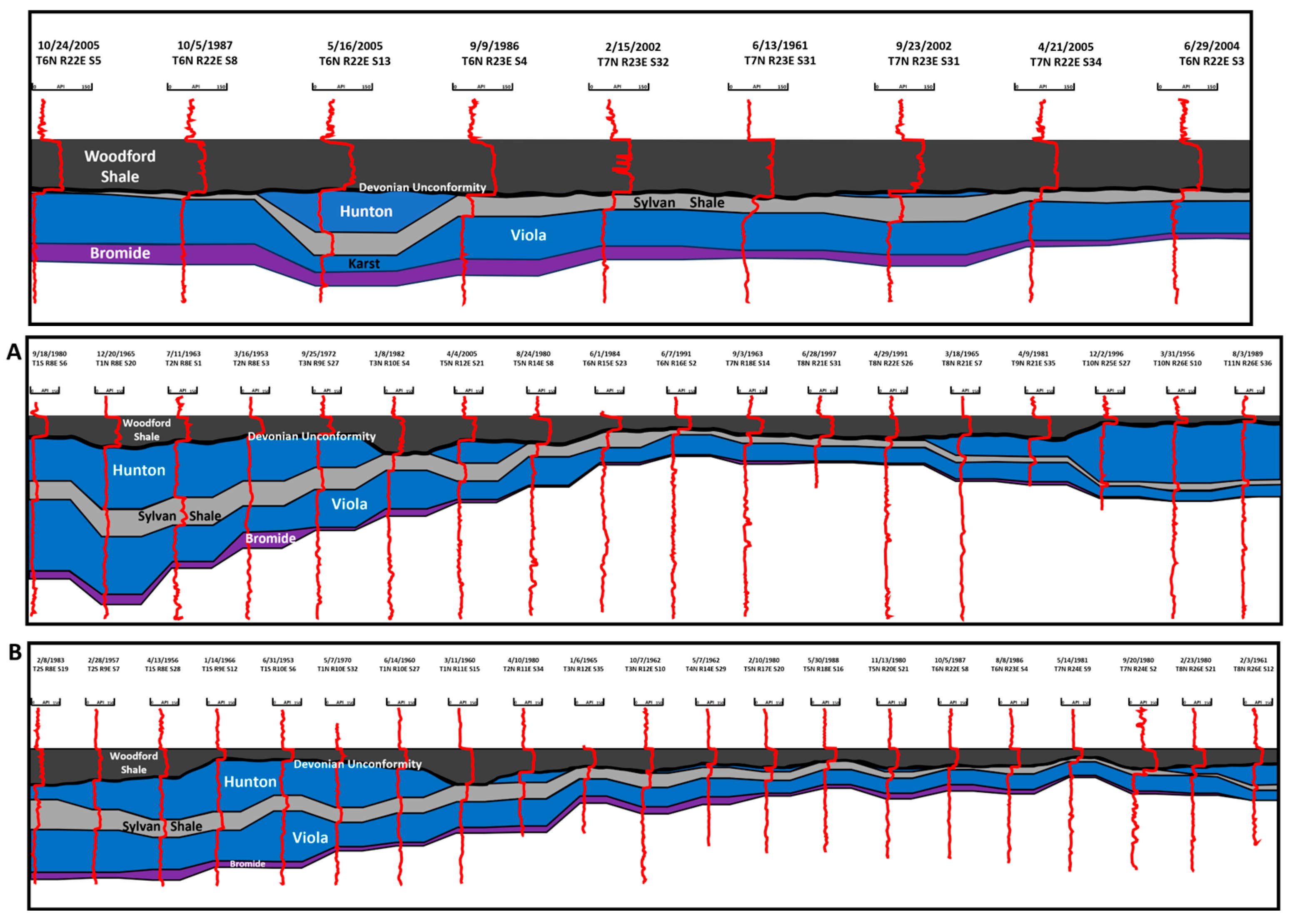

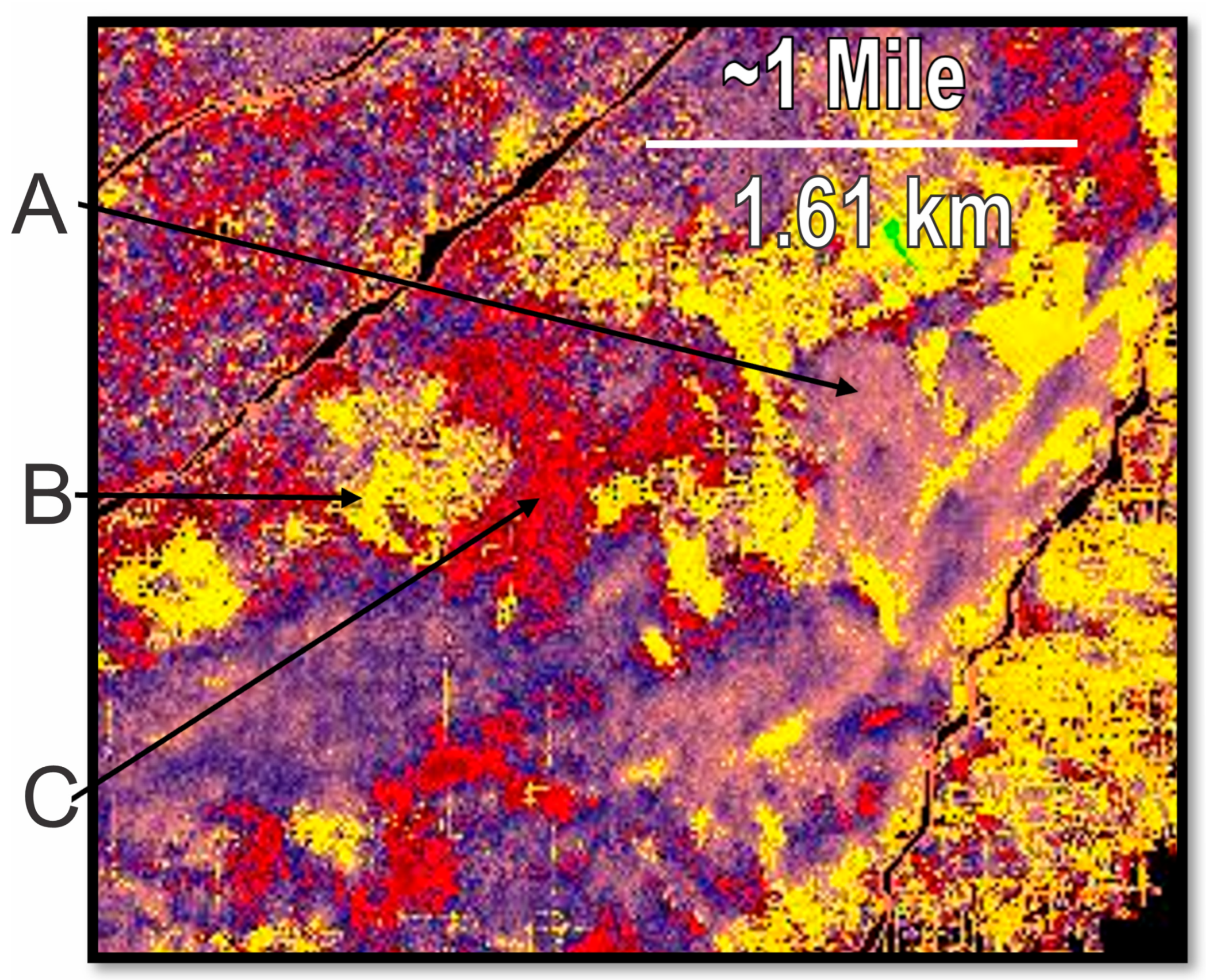


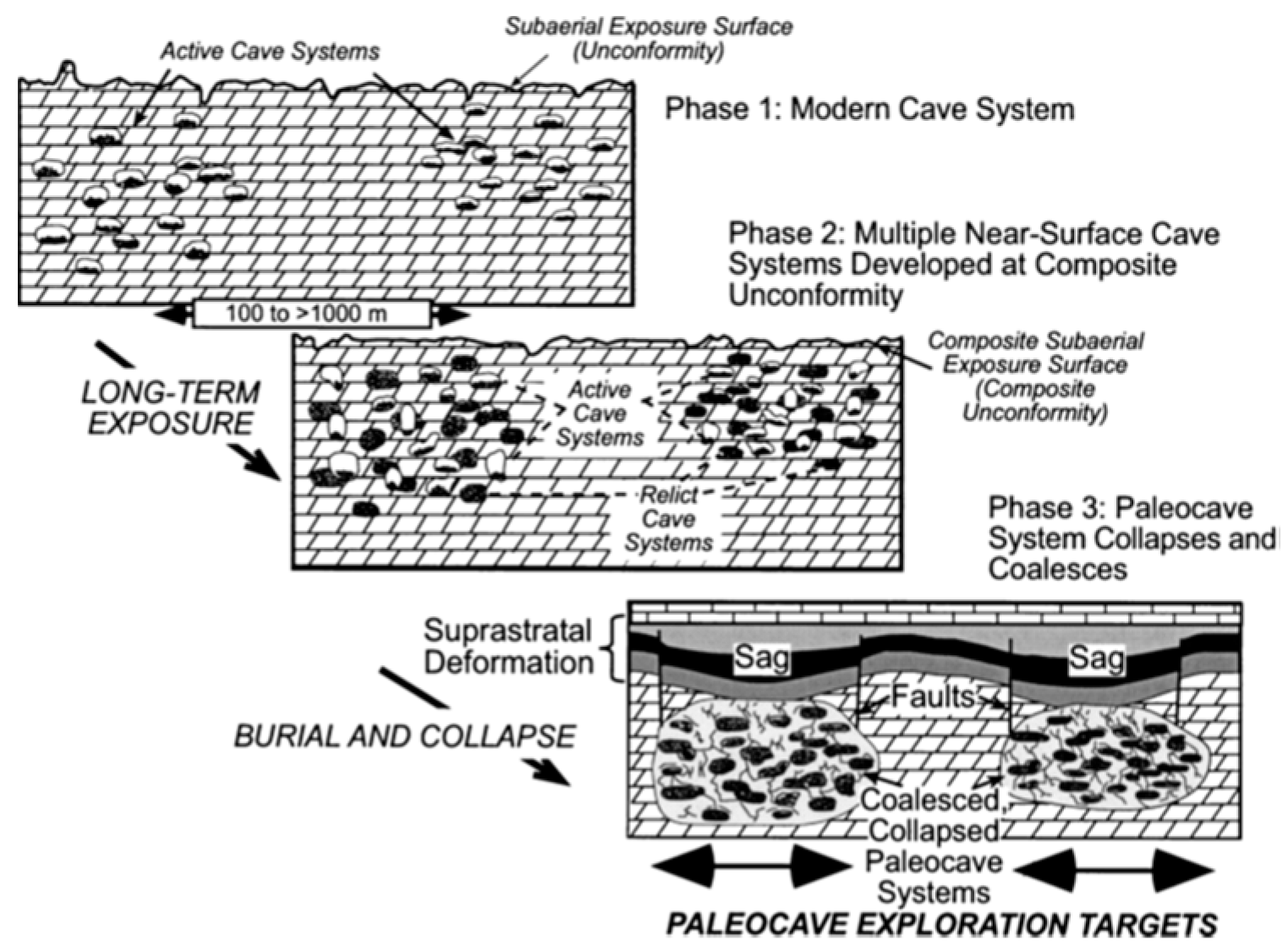
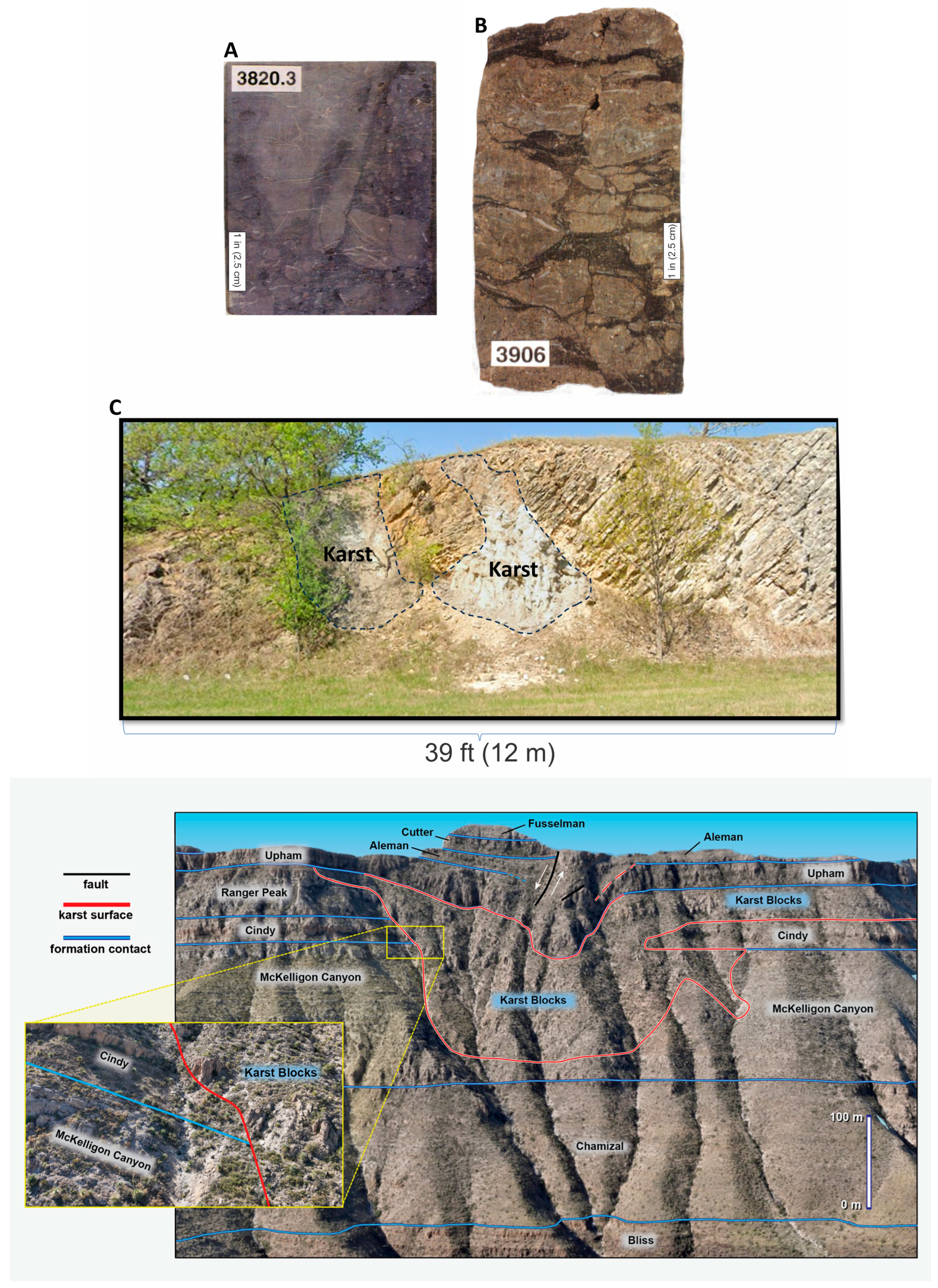
Disclaimer/Publisher’s Note: The statements, opinions and data contained in all publications are solely those of the individual author(s) and contributor(s) and not of MDPI and/or the editor(s). MDPI and/or the editor(s) disclaim responsibility for any injury to people or property resulting from any ideas, methods, instructions or products referred to in the content. |
© 2025 by the authors. Licensee MDPI, Basel, Switzerland. This article is an open access article distributed under the terms and conditions of the Creative Commons Attribution (CC BY) license (https://creativecommons.org/licenses/by/4.0/).
Share and Cite
Brinkerhoff, A.R.; McBride, J.; Keach, R.W., II; Ritter, S.M. Erosion and Karst in Subsurface Middle Paleozoic Rocks in the Arkoma Basin, Oklahoma, USA. Geosciences 2025, 15, 357. https://doi.org/10.3390/geosciences15090357
Brinkerhoff AR, McBride J, Keach RW II, Ritter SM. Erosion and Karst in Subsurface Middle Paleozoic Rocks in the Arkoma Basin, Oklahoma, USA. Geosciences. 2025; 15(9):357. https://doi.org/10.3390/geosciences15090357
Chicago/Turabian StyleBrinkerhoff, A. Riley, John McBride, R. William Keach, II, and Scott M. Ritter. 2025. "Erosion and Karst in Subsurface Middle Paleozoic Rocks in the Arkoma Basin, Oklahoma, USA" Geosciences 15, no. 9: 357. https://doi.org/10.3390/geosciences15090357
APA StyleBrinkerhoff, A. R., McBride, J., Keach, R. W., II, & Ritter, S. M. (2025). Erosion and Karst in Subsurface Middle Paleozoic Rocks in the Arkoma Basin, Oklahoma, USA. Geosciences, 15(9), 357. https://doi.org/10.3390/geosciences15090357






